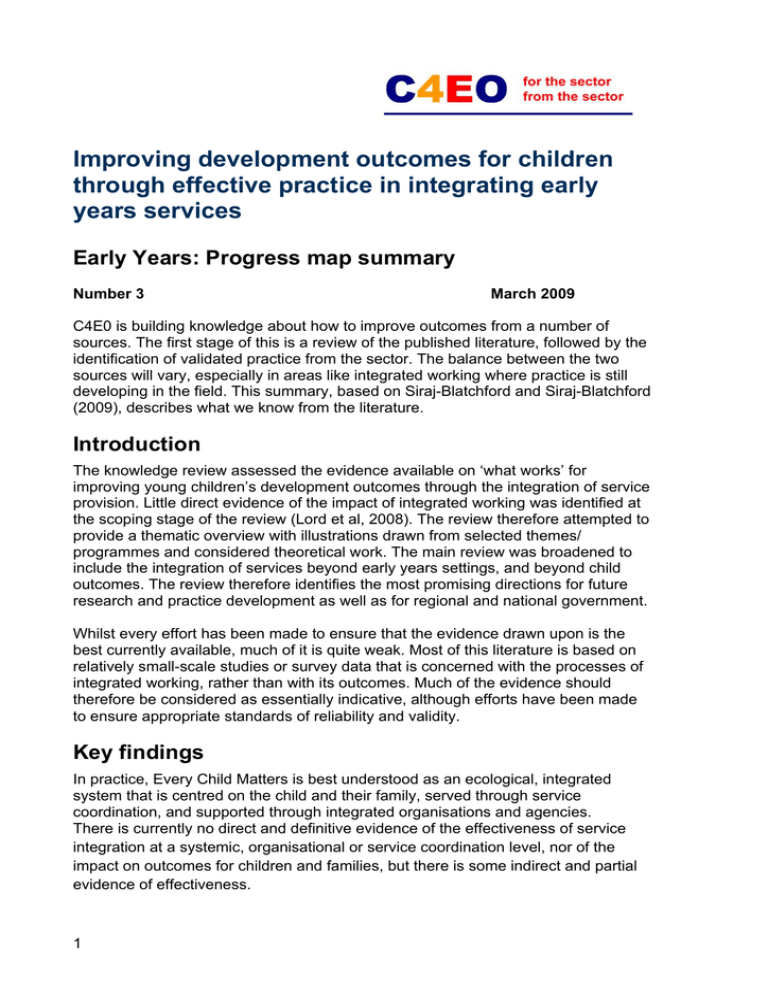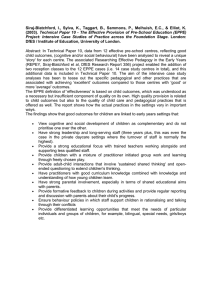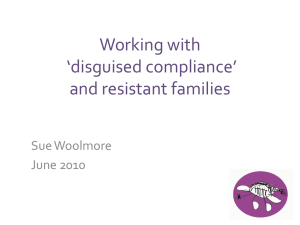
Improving development outcomes for children
through effective practice in integrating early
years services
Early Years: Progress map summary
Number 3
March 2009
C4E0 is building knowledge about how to improve outcomes from a number of
sources. The first stage of this is a review of the published literature, followed by the
identification of validated practice from the sector. The balance between the two
sources will vary, especially in areas like integrated working where practice is still
developing in the field. This summary, based on Siraj-Blatchford and Siraj-Blatchford
(2009), describes what we know from the literature.
Introduction
The knowledge review assessed the evidence available on ‘what works’ for
improving young children’s development outcomes through the integration of service
provision. Little direct evidence of the impact of integrated working was identified at
the scoping stage of the review (Lord et al, 2008). The review therefore attempted to
provide a thematic overview with illustrations drawn from selected themes/
programmes and considered theoretical work. The main review was broadened to
include the integration of services beyond early years settings, and beyond child
outcomes. The review therefore identifies the most promising directions for future
research and practice development as well as for regional and national government.
Whilst every effort has been made to ensure that the evidence drawn upon is the
best currently available, much of it is quite weak. Most of this literature is based on
relatively small-scale studies or survey data that is concerned with the processes of
integrated working, rather than with its outcomes. Much of the evidence should
therefore be considered as essentially indicative, although efforts have been made
to ensure appropriate standards of reliability and validity.
Key findings
In practice, Every Child Matters is best understood as an ecological, integrated
system that is centred on the child and their family, served through service
coordination, and supported through integrated organisations and agencies.
There is currently no direct and definitive evidence of the effectiveness of service
integration at a systemic, organisational or service coordination level, nor of the
impact on outcomes for children and families, but there is some indirect and partial
evidence of effectiveness.
1
What do we know with some certainty?
The review found that:
•
there is robust evidence that suggests combined approaches to intervention
(focusing on both children and family members) are effective, and this may
be considered to provide indirect evidence of effective integration
•
there is strong evidence that high-quality pre-school provision, that
integrates childcare and education, benefits children in terms of cognitive
and behavioural outcomes up the age of 11.
There is also some evidence to suggest that the quality rather than the type of
integration is what matters in terms of improving outcomes. We need,
therefore, to have a clear and shared understanding of what we mean by ‘quality’ in
integrated delivery of early years services, and to ensure that services adopt agreed
quality standards.
Various studies suggest that leadership training, the participation of
stakeholders, and participatory planning processes are all characteristics of
successful integrated working.
There is a need for specific training for staff managing and delivering integrated
services to ensure common understanding of how integrated services can deliver
the Every Child Matters agenda.
What do stakeholders think?
A number of studies include, or focus on the views of stakeholders (such as staff
and policy makers) concerning service delivery, and these findings indicate that:
•
there is some way to go before practitioners and stakeholders develop a clear
understanding of integrated services. The evidence suggests that the current
guidance and terminology associated with integrated service provision need
greater clarity
•
some stakeholders suggest that there is a tension between universal and
preventative services for children and/or between prevention and ‘safeguarding’.
Again this suggests the need for greater clarification of the Every Child Matters
objectives
•
some stakeholders believe that there needs to be agreed working and pay
structures in multi-agency teams, and greater clarification on the continued
funding of service integration
•
many stakeholders feel that the full potential of integration can only be achieved
when staffing levels match case-load demands.
Implications from the research for local service
improvement
For action by local decision makers and managers
The review findings indicate that the development of multi-disciplinary and
interdisciplinary approaches to delivery should be considered a high priority.
2
Based on the evidence gathering to date, we would suggest that:
•
there is a need to clarify the objectives of integrated working for all those
involved in service management and delivery
•
an approach to service assessment and intervention is needed that provides a
common language and greater agreement on service thresholds and tiers of
need
•
services should involve people who use services in planning and delivery
•
there is a need for training at all levels to develop: leadership for integrated
services; a shared philosophy and vision; better communication systems; a clear
staff review and supervision system; and shared understanding of roles
•
there is a need for training of service coordinators to ensure they have an
adequate knowledge of the full range of services available in supporting the
Every Child Matters agenda.
Implications for regional and national government
There is a need to provide further clarification of the core objectives of the Every
Child Matters policy, in relation to:
•
the respective needs of, and policy responses to, children and of families
•
the roles of universal, targeted and preventative services.
An overall strategy for service assessment and intervention is needed that provides
a common language and greater agreement on service thresholds and tiers of
need.
Better provision needs to be made for workforce development nationally and
regionally to support effective integrated delivery in the early years services.
There is a need for more robust research to be carried out in this area to address
the evidence gaps identified below. Further local research and development efforts
also need to be supported. The identification and promotion of agreed outcome
measures and standardised research instruments may be helpful.
What works?
Despite a generally weak evidence base, the review sought to identify the most
promising directions for future development and research, and to inform the
processes of linking future research more clearly with policy and practice. Two
research findings closely associated with the development of effective service
integration have been identified:
•
The adoption of combined approaches to intervention (i.e. focused on both
children and family members) are effective.
•
High-quality pre-school provision which integrates childcare and education is
beneficial.
Many other effective practices have been identified in the C4EO reviews concerned
with family-based support (Siraj-Blatchford and Siraj-Blatchford 2009) and
3
Narrowing the Gap (Coghlan et al 2009) and wherever possible integrated service
developments should be combined with these initiatives.
Gaps in the evidence base
Although there are significant challenges in designing research that could provide
hard evidence of the impact of service integration on outcomes, the review points to
the need for new multi-disciplinary research that investigates the processes by
which successful integrated working takes place in early years services. This should
be located within theoretical understandings of workplace practices and adult
learning.
The review also suggests that a coherent and holistic account is needed of the early
childhood developmental processes that provide the major justification for service
integration.
There is a need for more studies that identify the discrete models and features of
integration that are in current use and the most appropriate outcome measures for
evaluating their effectiveness. Studies on the work of social care professionals in
extended schools need to be replicated for children’s centres.
More rigorously designed studies should also be developed to identify the specific
features of effective integrated practice.
Main review
Siraj-Blatchford, I. and Siraj-Blatchford, J. (2009) Improving development outcomes
for children through effective practice in integrating early years services: knowledge
review 3, London: Centre for Excellence and Outcomes in Children and Young
People's Services (available at
http://www.c4eo.org.uk/themes/earlyyears/effectivepractice/files/c4eo_effective_pra
ctice_kr_1.pdf , accessed 24 March 2009).
Scoping study
Lord, P., Springate, I., Atkinson, M., Haines, B., Morris, M., O'Donnell, L., Benefield,
P., Harper, A. and Sharp, C. (2008) Improving development outcomes for children
through effective practice in integrating early years services: scoping review 1,
London: Centre for Excellence and Outcomes in Children and Young People's
Services (available at
www.c4eo.org.uk/themes/earlyyears/effectivepractice/files/c4eo_effective_practice_
scoping_study.pdf , accessed 21 January 2009).
Centre for Excellence and Outcomes in
Children and Young People’s Services (C4EO)
8 Wakley Street
London EC1V 7QE
tel 020 7843 6358
www.C4EO.org.uk
© C4EO 2009
All rights reserved
4



